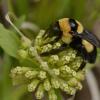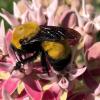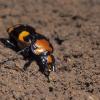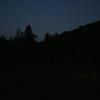
The byssus skipper has a wide range from southern Wisconsin to Florida. However, it is not continuously distributed and is very rare or at best locally abundant in some years in some places. Habitat in the Midwest is generally tall grass prairie, although in Missouri the byssus skipper seems to prefer wet areas within prairies, and in the northern part of its range it is mainly dry prairie or oak savannah. Along the Atlantic coast, the skipper is found on the edges of coasal marshes. The major threat is loss—or disturbance—of its habitat from prairie conversion or fire.
Taxonomic Status
(Lepidoptera: Hesperiidae: Hesperiinae)
Problema byssus (W. H. Edwards), 1880. There are two generally recognized subspecies, P. b. kumskaka (Scudder), 1887, found in the Midwest, and P. b. byssus (W. H. Edwards), 1880, found in the southeast. Other common names include bunchgrass skipper and golden skipper.
The byssus skipper is a medium sized butterfly in the family Hesperiidae (skippers). Its wingspan is 1⁷⁄₁₆ to 1¹³⁄₁₆ inches (3.7 – 4.6 cm). The uppersides of the wings are bright yellow-orange with broad black borders and a black bar at the cell. (The borders are so broad that at first glance the wings may appear black with a central yellow-orange patch.) The undersides of the wings are yellow-orange on the forewing and dull yellow on the hindwing (rust or orange on females). There is a black patch on the lower outer edge of the forewing (generally covered when at rest) and a band of pale spots on the hindwing.
There is one brood in the Midwest between June and July (spp. kumskaka) and two broods in the southeast between May and September, occasionally October (spp. byssus). Females lay eggs singly on hostplant leaves. The larval hostplants are eastern gamagrass (Tripsacum dactyloides) and big bluestem (Andropogon gerardii). Caterpillars live in shelters of leaves tied together with silk while feeding on the leaves. They overwinter as fourth instars and then resume feeding and growing in the spring. They pupate in silk cocoons in leaf litter. Adults feed on nectar from a range of flowers.
This butterfly has a wide range from southern Wisconsin to Florida. However, it is not continuously distributed and is in three disjunct regions: Wisconsin south to Arkansas and east to Indiana; Alabama and neighboring areas of Mississippi and Georgia; the Atlantic coastal plain from North Carolina to Florida.
Habitat for the byssus skipper varies across the range. In the Midwest it is generally tall grass prairie, although in Missouri is seems to prefer wet areas within prairies, and to the north it is mainly dry prairie or oak savannah. Along the Atlantic coast, the skipper is found on the edges of coastal marshes.
Xerces Red List Status: Vulnerable
Other Rankings:
Canada – Species at Risk Act: N/A
Canada – provincial status: N/A
Mexico: N/A
USA – Endangered Species Act: None
USA – state status: IA: Threatened
NatureServe: G3G4
IUCN Red List: N/A
Although apparently widespread, the byssus skipper is very rare or at best locally abundant in some years in some places. Isolation due to landscape fragmentation has resulted in many small populations that are at risk of gradual decline and extirpation. It is not found in highly disturbed locations and usually needs intact prairie.
The byssus skipper is listed as Threatened in Iowa. Heritage Programs in a number of states track this species, rating it as “extremely rare” (Wisconsin) to “rare and uncommon”; none consider it secure or even common. It is probably most secure in Iowa and Missouri.
The major threat is loss—or disturbance—of prairie habitat. In the Midwest, upwards of 99 percent of prairies have been converted since European settlers arrived. The fragments that remain are under continuing pressure from agricultural conversion, development, and neglect. Even those areas protected and managed for wildlife are not necessarily secure for the Byssus Skipper and other butterflies due to inappropriate management, especially prescribed burns.
In the Atlantic coast marshes, spraying to control mosquitoes is a likely threat.
Protection and careful management of prairie/savannah and marshland habitats should be a priority wherever populations occur. Management aims should include ensuring adequate hostplant and adult nectar plant abundance and to avoid disturbance from spraying or fire.
Surveys to identify populations of this butterfly should be done on any suitable habitat. Monitoring of known populations to assess status and trends should be done. Studies into the impacts of fire would be valuable, especially on the frequency and timing of burns.
Opler, P. A., and G. O. Krizek. 1984. Butterflies East of the Great Plains. Johns Hopkins University Press, Baltimore, MD.
Opler, P. A., and V. Malikul. 1992. A Field Guide to Eastern Butterflies. Peterson Field Guide #4. Houghton-Mifflin Co., Boston, MA.
Scott, J. A. 1986. The Butterflies of North America. Stanford University Press, Stanford, CA.
Stanford, R. E., and P. A. Opler. 1993. Atlas of Western USA Butterflies Including Adjacent Parts of Canada and Mexico. Denver and Fort Collins, CO.
Profile Prepared by Matthew Shepherd, The Xerces Society for Invertebrate Conservation.
Citation
Shepherd, M. D. 2005. Species Profile: Problema byssus. In Shepherd, M. D., D. M. Vaughan, and S. H. Black (Eds). Red List of Pollinator Insects of North America. CD-ROM Version 1 (May 2005). Portland, OR: The Xerces Society for Invertebrate Conservation.





